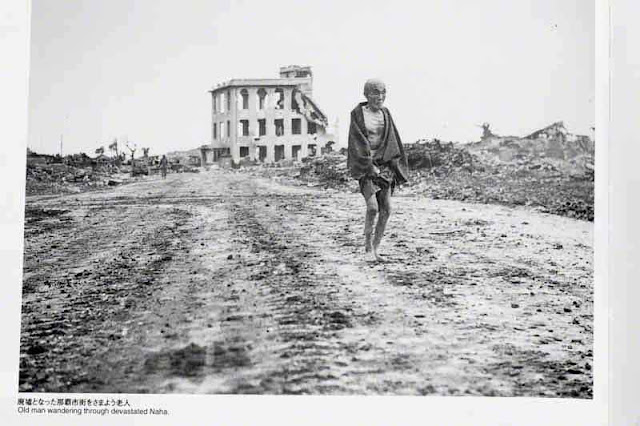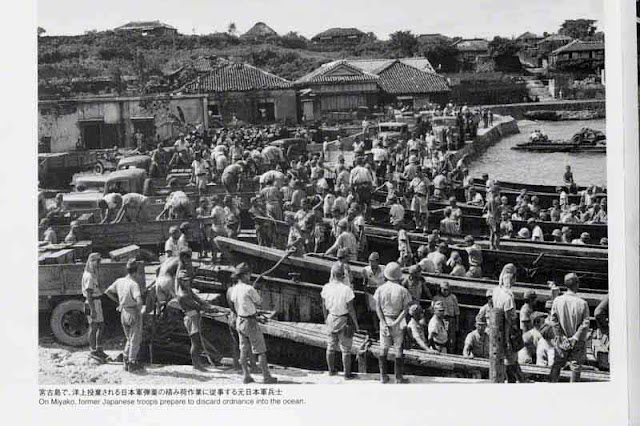Images from Okinawa the 50 Years of the Postwar Era
Some folks are itching to get into another war, these days so, I dug this up.
When two or more nations, can't settle things peacefully, things like this happen.
The bustling capital of Naha, was turned into rubble back in 1945.
There are plenty of civilians, women, children and elderly, who aren't involved in the quarrels.
But, they get to feel the ground rumble, smell the stench and, get blown away, too.
Not wanting to show the really gory things, I took a photo of this camp.
A few miles from where I'm sitting, was the Yaka POW holding area.
It would take some time, to sort out the bad guys from the good (Okinawan) ones.
A few thousand Okinawan prisoners, were sent off to Hawaii. What for ?
Many of them had been forced to fight alongside the Japanese Imperial Army as conscripts.
And, there really wasn't enough food left on the islands, to feed everyone.
These poor souls, got to return home about a year later. Some of them are still alive.
Japanese, told locals that the Americans would kill, torture and rape if, they were captured.
Fortunately, Okinawans who spoke English, talked folks into surrendering peacefully.
They saved plenty of people from, taking their own lives. That's heroes !
Here's another place, down the road from me. It's the Ishikawa market back in 1952.
It took a few years, to put things back together again. You wouldn't recognize the place now.
It has paved roads with sidewalks and, new, shiny buildings everywhere.
Nowadays, Itoman City is a sprawling metropolis, you could get lost navigating.
Someday, I may have to try and duplicate this photo for a Then and Now.
The photo was taken in 1951 and, doesn't resemble today's Itoman rotary, at all.
To survive, many people had to be imaginative and, create their own industries.
Any scraps of metal, wood or foods, from the bases, could turn a profit if, you knew how.
An enterprising GI or two, sometimes helped the marketplace, I imagine.
If, ya got caught sneaking goods off the base, a person, could go to jail.
Things like that still happen, today !
Outer Islands
The war took place on many of the Ryukyu Islands, not just this one.
While, I was poking around in the historical records, a few new things were discovered.
Allies from the British Royal Navy bombarded the crap out of the southern islands airfields.
That way, when the US Forces arrived, they didn't need to fight anybody.
Y'all Brits done a bloody good job. Bravo !
Lord only knows, what the Imperial Monsters were doing with a train, on this little island.
But, once the civilians, got ahold of it, they had a sugarcane express and shuttle bus.
Sometimes, I wish we had one of those locomotives on this island. Stupid monorail, ain't no fun.
Whenever these wars end, the winner gets to make the losers disarm themselves.
Nowadays, I think they know better than, to throw trash into the ocean.
Back to the Civilians
Going through this book, which is really a photographic history of Okinawa, reminded me.
It brought back memories, I keep locked away in dark recesses of my brain.
Deliberately, I passed over images, depicting the slime, scents and gore of ground warfare.
Not what you could call an active pacifist, I believe there will always be wars.
Getting up there in age, I don't/won't start a fight with anyone in this world.
Nobody, has any business, killing innocent civilians or, destroying their countryside.
The Battle of Okinawa, destroyed homes, farms, chickens, pigs, cows, goats and horses.
More than 100,000 civilians died and, the living were left starving.
I read a narrative about a young woman, collecting the belts off of dead Japanese soldiers.
That was, to cook for her family, as meat because, there were no animals left alive.
What did those civilians do, to deserve the hell that descended upon them ?
Before anyone decides to start shooting weapons at another country, think about it.
Win, lose or draw, someone has to put the civilian population, back together again.
Photos from "Okinawa The 50 Years of the Postwar Era."
Book jacket ISBN4-89095-085-0 does not appear in Google Search













No comments:
Post a Comment